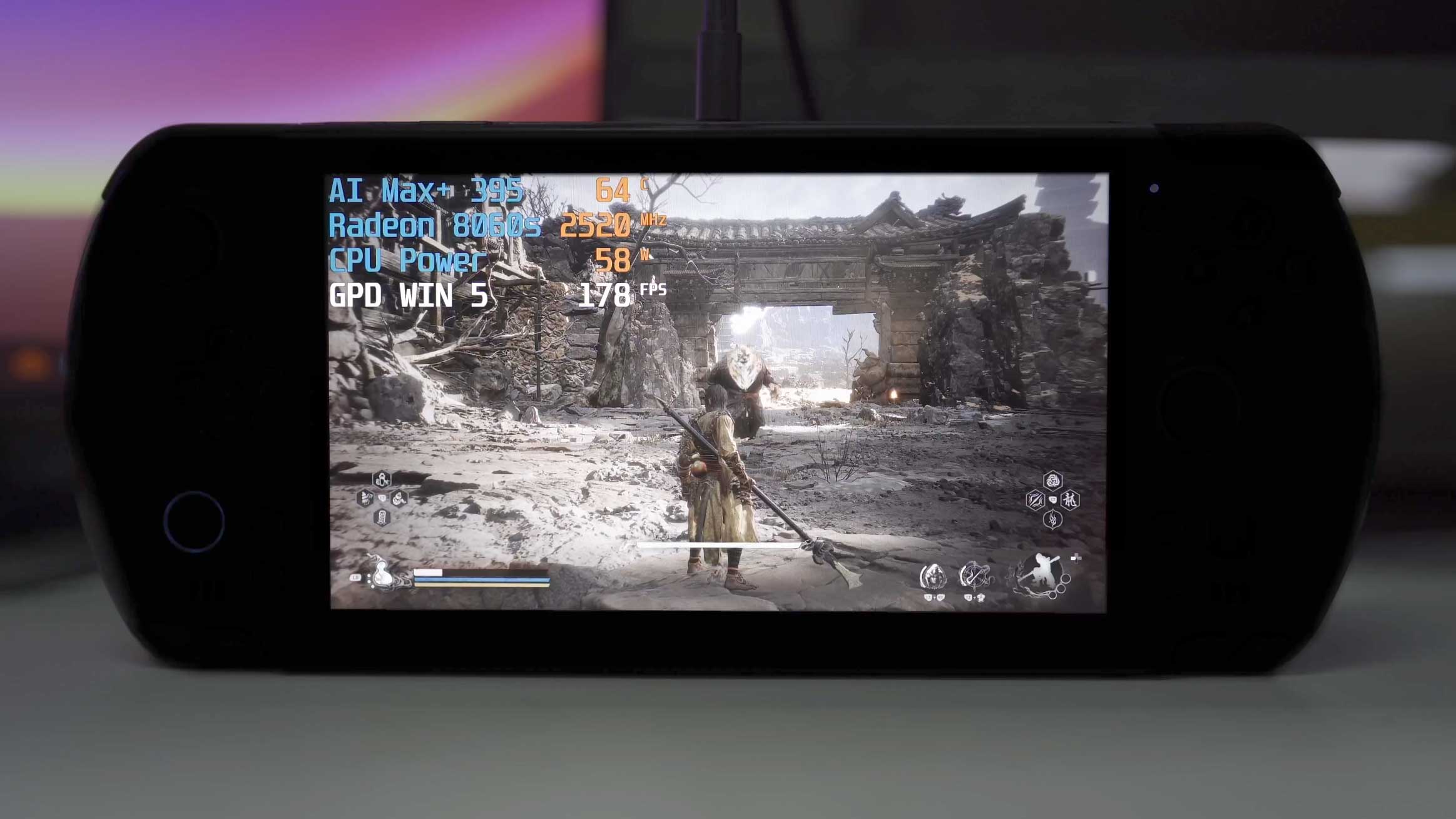AMD Strix Halo-powered gaming handheld reveals desktop-like GPU performance — Ryzen AI Max+ 395 was a hairline from the RTX 4060

GPD teased the first AMD Strix Halo-powered handheld console in late July, promising that it will make its public debut at the ChinaJoy expo in Shanghai, China. After its reveal, several Chinese creators are getting their first impressions of the overpowered handheld PC, running benchmarks on the system. Jobs_Bao tested the Win 5 on the showroom floor, running Cinebench R23 and Time Spy benchmarks and sharing the results on Bilibili.
The handheld achieved a score of 30,495 points on the former, enabling it to deliver performance comparable to that of desktop-class Intel Core i9-13900HX processors. What’s more impressive is that it achieved this record with the CPU reaching a maximum temperature of 80.3 degrees Celsius while running at full tilt. Even so, the exhaust vents at the top of the Win 5 only recorded a temperature of just over 45 degrees Celsius, with the fans running at around 95dB, making it quite convenient to play with.
As for its graphics performance, it achieved 9,680 points with Time Spy — within spitting distance of the record set by the RTX 4060. Unfortunately, GPD limited the AMD Ryzen AI Max+ 395 on this device to just 70 watts, about 50 watts short of its 120-watt maximum capacity. As a result, the console is unable to harness the laptop-beating power of the Radeon 8060S integrated into the APU. Nevertheless, this should be enough performance to play many games at Ultra settings at 1080p resolution. Another creator, PureDIY, posted a video on Bilibili playing Black Myth: Wukong on the handheld, achieving an average of more than 80 FPS on the console.
The most notable feature of the GPD Win 5 is its battery, which boasts a 5,170mAh capacity. Instead of being built into the console, it comes as a separate unit that can be easily placed and removed from the back of the console. Although some people were taken aback by this design, especially as it adds some heft to the handheld (around 340 grams), it’s advantageous as you can easily swap it out while on the go. Aside from that, you don’t have to keep it on the back of the Win 5 if you intend to use it while attached directly to its massive 180-watt charging brick.
The GPD Win 5 is available in two options: the top-tier device, powered by the AMD Ryzen AI Max+ 395 with the Radeon 8060S integrated GPU and a memory capacity of up to 128GB, and a more affordable variant that features the Ryzen AI Max 385 and an integrated Radeon 8050S GPU. Unfortunately, we haven’t seen the pricing details yet, so we don’t know how much these units will cost.
Follow Tom's Hardware on Google News to get our up-to-date news, analysis, and reviews in your feeds. Make sure to click the Follow button.
Get Tom's Hardware's best news and in-depth reviews, straight to your inbox.

Jowi Morales is a tech enthusiast with years of experience working in the industry. He’s been writing with several tech publications since 2021, where he’s been interested in tech hardware and consumer electronics.
-
abufrejoval I'm sure at €4000 for the 128GB model will sell like hot cakes...Reply
At least that's what HP charges for the BigNUC variant.
StrixHalo is nice tech, but charging €2000 for 128GB of quite ordinary LP-DDR5 RAM is usury. -
zsydeepsky This is not a handheld, it's just a Strix Halo mini PC with a special case.Reply
As an owner of three handhelds, I would say that any platform with a TDP over 25W is a nightmare for this genre. For heat\noise\battery life\weight compromises, they all wreck the overall ergonomics. -
usertests Reply
It's real bad, tolerated in an AI hype bubble context since the capacity is helping it beat the 4090 and such with larger models. That nobody was able to make CAMM or anything else upgradeable work with a quad-channel mega APU marks a shameful moment for the industry. Using 64 GB DDR5 SODIMMs, you could even have 256 GB in a Strix Point laptop/system, though the lower performance and bandwidth will limit its utility.abufrejoval said:I'm sure at €4000 for the 128GB model will sell like hot cakes...
At least that's what HP charges for the BigNUC variant.
StrixHalo is nice tech, but charging €2000 for 128GB of quite ordinary LP-DDR5 RAM is usury.
For gaming, 32/64 GB is fine. Unfortunately, there is no 48 GB option, which would allow you to dedicate 16 GB as VRAM and keep 32 GB for the CPU, while saving some money from 64 GB.
Strix Halo can technically beat everything else at TDPs of around 20W and up, but not by enough limited at 25W to justify the price. A "good" Strix Halo handheld is plausible, but only if you ignore the price.zsydeepsky said:This is not a handheld, it's just a Strix Halo mini PC with a special case.
As an owner of three handhelds, I would say that any platform with a TDP over 25W is a nightmare for this genre. For heat\noise\battery life\weight compromises, they all wreck the overall ergonomics.
There is one trick AMD hasn't pulled for Strix Halo: 3D V-Cache. It's possible (but not confirmed) that the CPU chiplets could have cache added. They are arranged differently than Granite Ridge, so there could be complications, but Zen 6 Olympic Ridge + X3D could look similar. Voltage and clock speeds would be dropped slightly. AMD could also pair a single CCD 8-core with the full 40 CUs. By doing all of the above, you would have a Strix Halo SKU optimized for handhelds, but probably still not doing anything earth-shattering at 10-25W TDPs.
It's possible that cooling and battery technologies will improve in the future to make 35W-50W handhelds more viable. For example, solid state active cooling like AirJet or xMEMS, and any development that significantly increases the energy density of batteries (e.g. 1.5x - 5x of today's). But we're looking 10 years or more into the future for those. -
abufrejoval Reply
To be fair, AMD can't really design for hardware that doesn't exist, so this was a bit of a chickens and eggs problem back when Strix Point was on the drawing board. According to Framework, AMD did try to make LP-CAMM work, but failed with the finished APUs. They couldn't just go back to the drawing board to please a niche audience, they are late making money on those chips already (but overcharging doesn't get you economy of scale, AMD!)usertests said:It's real bad, tolerated in an AI hype bubble context since the capacity is helping it beat the 4090 and such with larger models. That nobody was able to make CAMM or anything else upgradeable work with a quad-channel mega APU marks a shameful moment for the industry. Using 64 GB DDR5 SODIMMs, you could even have 256 GB in a Strix Point laptop/system, though the lower performance and bandwidth will limit its utility.
With SOCAMM finding such a broad adoption, I think there is a good it will change with the next generation.
The allocation isn't really isn't that set in stone. The chipset will set a GPU exclusive minimal amount via the BIOS, and deduct that from OS usable RAM, to ensure the GPU can perform to a well defined minimum.usertests said:For gaming, 32/64 GB is fine. Unfortunately, there is no 48 GB option, which would allow you to dedicate 16 GB as VRAM and keep 32 GB for the CPU, while saving some money from 64 GB.
It then also sets a maximum amount depending on the total RAM available, that excludes a minium, that cannot claimed by the GPU dynamically, probably to ensure the OS can keep doing it's job. All the RAM in-between then gets managed via a first-come, first-serve policy, where at least the RAM used by the GPU is likely locked and won't get paged.
Obviously just how well that works, depends on OS and driver support: it seems fine on Windows, I haven't checked on Linux yet.
On my Hawk Point system with 64GB of RAM, I dedicate 4GB to the GPU exclusively and it seems to divide the remaining 60GB 50/50, so that the GPU can use a maximum of 34GB, if the CPU didn't get there first. Actually, perhaps the OS might even page CPU memory so the GPU can get more, which might explain that the barrier is set at 50% to avoid thrashing.
But I haven't tried pulling RAM to validate that 50% formula and perhaps it's up to the BIOS to change it. Nor have I felt overly tempted to try 128GB: it's only €350 for dual 64GB SO-DIMMs, not the €2000 they charge on Strix Halo, but that's still more than I paid for the entire Hawk Point board including the APU.
From looking at the Amuse app logs it seems the NPU gets access to 30GB as well. If that is from the CPU pool or the shared GPU pool, I cannot tell, ideally the NPU should be able to work with both, to avoid communications overhead via bounce buffers, but that's another topic.
So a 48GB configuration should get you 4GB dedicated and 22GB dynamic for a total of 26GB usable by AI models, while 44GB would remain usable when you're not running AI workloads.
I guess the main issue is that there aren't 12Gbit or rather 6Gbit RAM chips out there to support a 48GB RAM size. If you mixed capacities, you'd loose the bandwidth advantage on half of your memory, which makes that rather unattractive.
No, they should just stop the usury and start selling 64 and 128GB options at what LP-DDR5 costs on the free market.